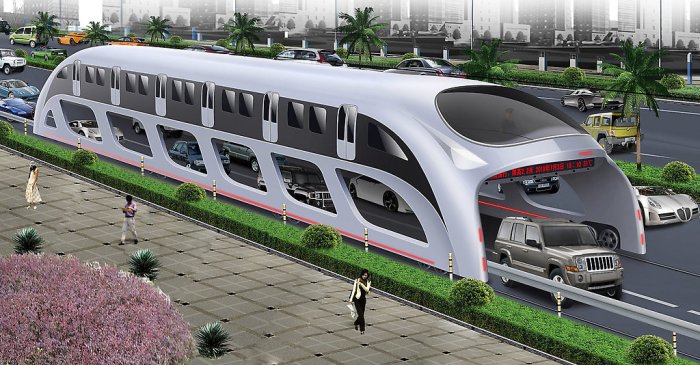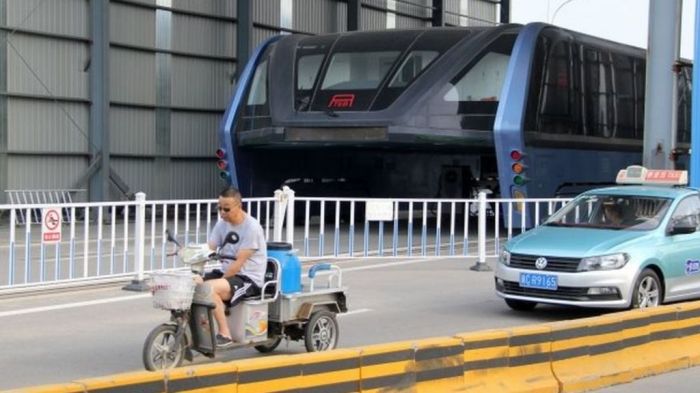China Straddling Bus Is Real: The Truth Behind the Viral Phenomenon. Remember those images and videos of a futuristic bus that straddled traffic, carrying passengers over the heads of cars? It was everywhere, from social media to news outlets. The concept promised a solution to traffic congestion, a dream come true for city dwellers. But the reality of the “China straddling bus” was a bit more complicated, leaving many to wonder if it was real or just a clever hoax.
The idea of a straddling bus, while seemingly outlandish, isn’t entirely new. Similar concepts have been explored for decades, but the “China straddling bus” gained global attention due to its viral spread, fueled by exaggerated claims and lack of concrete evidence. This phenomenon raises questions about the role of social media in shaping public perception and the spread of misinformation, particularly when it comes to emerging technologies.
The Concept of the Straddling Bus
The straddling bus, also known as a transit elevated bus (TEB), is a unique transportation concept that aims to address traffic congestion in urban areas. It’s designed to straddle existing roads, with its passengers traveling above the traffic flow, potentially offering a more efficient and less congested mode of transport.
The straddling bus concept has been met with both excitement and skepticism. Proponents see it as a revolutionary solution to traffic woes, while critics question its feasibility and practicality.
Design and Functionality
The straddling bus is essentially a large, elevated platform with a central carriage for passengers. This platform spans the width of the road, with the carriage positioned above the vehicles traveling on the road below. The bus runs on rails that are installed along the sides of the road, allowing it to move smoothly over the traffic.
The design incorporates several key features:
* Elevated Platform: The platform is raised above the road surface, allowing the bus to travel over traffic. This minimizes the impact on existing road infrastructure and allows for uninterrupted traffic flow below.
* Central Carriage: The passenger carriage is located in the center of the platform, offering a spacious and comfortable environment for passengers.
* Rail System: The straddling bus operates on a dedicated rail system, ensuring smooth and efficient movement. This system is designed to be compatible with existing road infrastructure.
Potential Benefits
The straddling bus concept promises several potential benefits, including:
* Increased Traffic Capacity: By operating above existing traffic, the straddling bus can significantly increase the overall capacity of the road network. This can help alleviate traffic congestion and reduce travel times.
* Reduced Congestion: The straddling bus’s ability to travel over traffic flow can help reduce congestion on the road below, leading to smoother traffic flow and shorter travel times.
* Environmental Benefits: The straddling bus can potentially be powered by renewable energy sources, reducing its carbon footprint and contributing to a more sustainable transportation system.
Similar Transportation Concepts
The straddling bus concept is not entirely new. Similar concepts have been explored and implemented in various forms around the world. Examples include:
* Elevated Light Rail: Elevated light rail systems are commonly found in many cities, with trains running on elevated tracks above ground level. This system shares similarities with the straddling bus in terms of its elevated design and ability to reduce traffic congestion.
* Bus Rapid Transit (BRT): BRT systems often feature dedicated bus lanes and priority traffic signals, creating a faster and more efficient bus service. While not elevated, BRT systems also aim to reduce congestion and improve public transportation.
The “China Straddling Bus” Phenomenon
The “China straddling bus” phenomenon, a viral sensation in 2016, captured the world’s attention with images and videos of a futuristic-looking vehicle seemingly straddling regular traffic. This concept, however, was not as real as it appeared. The viral images and videos were actually part of a carefully orchestrated marketing campaign, and the bus itself was a prototype that never went into production.
The Origins of the Viral Images and Videos, China straddling bus is real
The initial images and videos of the “China straddling bus” originated from a company called “Tethers” in 2010. They were meant to showcase the company’s concept for a new type of public transportation, which they claimed would be more efficient and environmentally friendly than traditional buses.
The concept of the straddling bus was based on the idea of a large, elevated vehicle that would run on rails, allowing it to pass over regular traffic. The bus was designed to have a wide, open middle section that would allow cars to pass underneath it. This, the company claimed, would reduce traffic congestion and improve air quality.
The images and videos released by Tethers were quickly picked up by media outlets around the world, generating significant buzz and excitement. Many people were impressed by the concept and believed that it could revolutionize transportation.
The Source of the Claims and Their Impact on Public Perception
However, the claims made by Tethers about the straddling bus were soon met with skepticism from transportation experts. They pointed out several practical challenges that would make it difficult to implement such a system, including the cost, safety, and infrastructure requirements.
Despite the skepticism, the images and videos of the straddling bus continued to spread online, fueled by social media and news websites. The public’s fascination with the concept, coupled with the lack of critical scrutiny, led to a widespread belief that the bus was real and ready to be deployed.
The widespread attention and interest in the “China straddling bus” had a significant impact on public perception. It highlighted the public’s desire for innovative and futuristic transportation solutions. However, it also demonstrated the power of viral marketing and the potential for misinformation to spread quickly online.
Factors Contributing to the Widespread Attention and Interest
Several factors contributed to the widespread attention and interest in the “China straddling bus.” These included:
- The novelty of the concept: The straddling bus was a unique and eye-catching idea that captured the imagination of people around the world. It was a stark departure from traditional buses and seemed to offer a solution to the problem of traffic congestion.
- The visual appeal of the images and videos: The images and videos of the straddling bus were well-produced and visually impressive. They showed the bus in action, seemingly gliding over traffic with ease. This helped to create the impression that the concept was feasible and ready for implementation.
- The lack of critical scrutiny: The initial reports about the straddling bus were often uncritical and focused on the potential benefits of the concept. This lack of scrutiny allowed the misinformation to spread unchecked.
- The power of social media: Social media platforms played a significant role in spreading the images and videos of the straddling bus. The virality of the content helped to ensure that it reached a wide audience.
Reality vs. Hype: China Straddling Bus Is Real
The “China Straddling Bus” captured global attention with its futuristic design promising to revolutionize urban transportation. However, the reality of this technology remains a subject of debate, with claims of its operational status often met with skepticism. This section delves into the truth behind the straddling bus, examining its actual development, limitations, and feasibility compared to other transportation solutions.
The Reality of the Straddling Bus
While the concept of a straddling bus has existed for decades, the specific design that gained widespread attention in 2016, dubbed the “Transit Elevated Bus” (TEB), has faced significant challenges.
- Limited Operational Evidence: Despite initial claims of successful test runs, there is no verifiable evidence of the TEB operating in a real-world environment, carrying passengers, or achieving its purported efficiency.
- Technical Challenges: The TEB’s design, which involves a large vehicle straddling existing roads, poses numerous technical hurdles, including stability, safety, and integration with existing infrastructure.
- Financial and Regulatory Hurdles: The high cost of developing and implementing such a complex system, coupled with the need for significant infrastructure modifications and regulatory approvals, presents significant financial and logistical challenges.
Challenges and Limitations
The implementation of a straddling bus system faces several challenges, including:
- Stability and Safety: The TEB’s stability on elevated tracks, especially in adverse weather conditions or during high winds, raises concerns about passenger safety.
- Infrastructure Compatibility: The TEB’s design requires modifications to existing roads and infrastructure, posing significant challenges for integration into existing urban environments.
- Accessibility and Maintenance: The elevated design could limit accessibility for pedestrians and emergency vehicles, while maintenance and repairs could disrupt traffic flow.
Feasibility Compared to Other Solutions
The feasibility of the straddling bus concept needs to be evaluated against other existing transportation solutions, such as:
- Light Rail Transit (LRT): LRT systems offer higher capacity, more reliable operation, and greater integration with existing urban environments compared to the TEB.
- Bus Rapid Transit (BRT): BRT systems offer a cost-effective and efficient solution, often with dedicated lanes and priority at intersections, providing faster travel times than the TEB.
- Elevated Rail Systems: While expensive, elevated rail systems offer high capacity, speed, and reliability, making them a viable option for major urban corridors.
The Impact of the Straddling Bus Myth
The “China straddling bus” phenomenon, despite its fictional nature, had a significant impact on the cultural and social landscape. The widespread sharing of images and videos, often without proper verification, created a wave of excitement and curiosity around this purported innovation. While the myth itself was debunked, its influence on public perception of transportation technology and the role of social media in shaping narratives remain noteworthy.
The Role of Social Media and Misinformation
The rapid spread of the “China straddling bus” myth was largely fueled by social media platforms. The captivating images and videos, often presented without context or critical analysis, quickly went viral, reaching millions of users worldwide. This rapid dissemination contributed to the myth’s widespread acceptance, highlighting the potential for misinformation to spread unchecked in the digital age.
Social media platforms often prioritize engagement over accuracy, leading to the amplification of sensationalized content, even if it is demonstrably false.
This phenomenon underscores the importance of media literacy and critical thinking in navigating the vast and often unreliable information landscape online.
The “China Straddling Bus” phenomenon serves as a stark reminder of the power of social media and the ease with which misinformation can spread. While the concept of a straddling bus holds some potential, the reality is that it remains a distant dream. The hype surrounding the “China Straddling Bus” ultimately serves as a cautionary tale, reminding us to be critical of information we encounter online and to seek out credible sources before forming opinions.
Remember the China straddling bus, that futuristic vehicle that promised to revolutionize transportation? Well, it turns out it was more of a viral sensation than a reality. And it seems that even the most advanced humanoid robots, like those showcased at MODEX, humanoid robots face continued skepticism at modex , are still facing a similar level of skepticism. Maybe we’re just too used to seeing futuristic concepts that never quite make it to the real world.
But hey, at least we can still dream of that straddling bus zipping us through traffic, right?
 Standi Techno News
Standi Techno News

